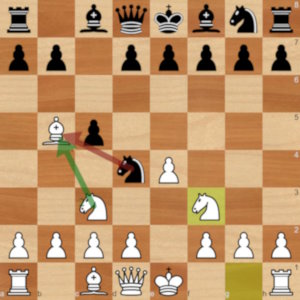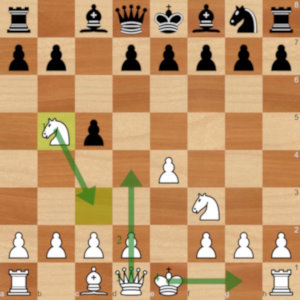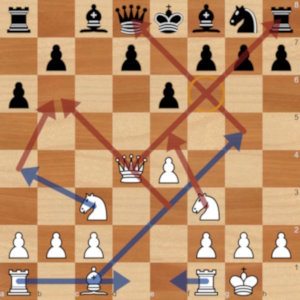How to handle the Sicilian as White
 When I first stumbled upon this variation, I thought I would name it something simple, like the Kiselev variation or Butcher the Sicilian, because Miodrag Perunovic wrote a course covering it and GM Vitaliy Kiselev played a lot of it against the Sicilian. Even Gotham Chess and Will Graif recommended it in some videos. But then I realized that most people won't read the blog unless I have a beautiful woman as the thumbnail, so for the purposes of views and likes, I will call this variation The Beckinsale. I bet Big Mio wishes he'd have thought of it.
When I first stumbled upon this variation, I thought I would name it something simple, like the Kiselev variation or Butcher the Sicilian, because Miodrag Perunovic wrote a course covering it and GM Vitaliy Kiselev played a lot of it against the Sicilian. Even Gotham Chess and Will Graif recommended it in some videos. But then I realized that most people won't read the blog unless I have a beautiful woman as the thumbnail, so for the purposes of views and likes, I will call this variation The Beckinsale. I bet Big Mio wishes he'd have thought of it.
Now, other than the poster, this is no joke. This reply to the Sicilian sidesteps most theory and is, statistically, the best weapon against the Sicilian on Lichess. And I mean it for ratings above 1800, games that are not bullet or even blitz and that were played in the last year. Serious stuff! While Mio would probably explain it better, I can tell you that following these lines leads to some really cool ideas, but also very simple ones. Yes, the Beckinsale is as easy on the moves as it is on the eyes.
So how does a total noob find something new in what is probably the most theoretically examined defense for Black? Well, simple: use the wonderful Lichess database, maybe with my own LiChess Tools extension installed to help you out, and look not for the best Stockfish moves, but for the most winning moves, or maybe the sharpest. Yes, there is a huge difference. Positions where the evaluation of the most played move is terrible is what keeps YouTubers fed.
Have you tried learning the Sicilian? With its many variations (uninspiringly) named after ugly male chess players, long theoretical lines which "win" because some extra pawn in the end game? Not only is it horrible, but it is boring as well. If you are a grandmaster, surely you don't care about what I have to say, but if you are not, you probably know that the most common form of the Sicilian is the so called Open Sicilian, consistently played six or seven times more often than the Closed Sicilian. Well, guess what we're going to play? Nc3! Bye-bye, OS!
Black will play Nc6, the "Traditional, Closed" variation, because they are boring and uncreative, and we will play Bb5, threatening to capture the knight and double Black's pawns. Why are we even bothering threatening stuff that won't really matter at our level? Donno! But everybody is hung up on these pawns and their structure, so Black will reply by moving the knight away, attacking our bishop and threatening to take it and be the ones keeping the bishop pair. For some reason. So they will play Nd4. To which we will play The Beckinsale! Back when she was all dressed in leather and hunting werewolves: Nf3.

They will take. a6, d6 and g6 are also moves, but they won't play them. It makes little sense, they want the bishop pair. Even before, they didn't have to play Nc6, they could have played d6, e6 or g6, and they often do, sometimes it transposes, because where else is that knight going to go? And after Nxb5 and Nxb5 your moves, as White, are 90% of the time THE SAME! No theory, no complicated rules. Everything simple, like this:

They will probably kick your knight back Nc3, you will play d4, they will take and you will take with the queen Qxd4 - go Kate!, since there is no queenside knight on the board anymore, then castle short O-O. Four moves you don't have to think about, winning time that your opponent has to spend thinking. And there is more:
- on Nf6, you play Bg5
- on b5, you play Bf4 or a4
- on Qc7 or Bb7, you play a4.
- if they attack your queen, Qb4, even with the risk of a discovered attack on pawn push
- your knight will go Na4! How dim is that? But it will coordinate with the queen to attack the hole on b6, a perfect outpost.
- if the dark bishop is out, you can even castle queenside O-O-O
- if they don't kick your knight on b5 away, then the queen and the knight will be unstoppable on c7.
The ideas are very simple:
- induce the only developed Black piece to exchange itself
- capture the only forward pawn of Black
- get your pieces out quick
- attack the vulnerable queenside as fast as possible
- block Black's attempts to develop
Meanwhile, Black has moved just pawns:

The situation is as follows: White has three pieces out, a centralized queen and a safe king. Black has... long term plans. Which one would you pick?
And I know I will get comments like "A Sicilian player would never..." or "Stockfish says the position is equal" or even "You went Nf3 and d4 anyway, how is this not an open Sicilian?". You will probably not defeat Caruana with it, but most Lichess players will fall for it and Stockfish doesn't count here.
But even so. For all Lichess players for all time, this variation wins for White in 57% of the cases, to Black's 38%. Restrict the database to 1800+, Rapid+ and the last year and you get 51% over 39%. For 2200+ it's 47/41. For the Masters: 54/31 . Against the Sicilian! In the four games played at 2500+ level on Lichess in the last year in serious games, three games were won by White.
Enough teasing. I wrote a study about it, based on the most played moves on Lichess and what the best responses are. Then there are some really fun lines and games, for your entertainment.
How to handle the Sicilian as White
Let me know how you CRUSHED with it, or whatever is memeable now. And as always, have fun!
Comments
Hi there 👋 Really appreciated your take — concrete, practical, no-nonsense. That's exactly the mindset I try to support at MyChessPosters.com, where I design visual opening trees based on real-world data. I'm currently working on a Sicilian Defense poster, and I’m focusing on what matters most: 📊 Popularity among actual players 🏆 Win rate by rating level — because the best move on paper isn’t always the best in practice The idea is to help players see the big picture at a glance, and choose lines that actually perform. If you're into that kind of data-driven prep, I’d love to hear which lines worked best for you! Cheers, Phil – MyChessPosters.com Visual Chess Opening Posters
MyChessPosters